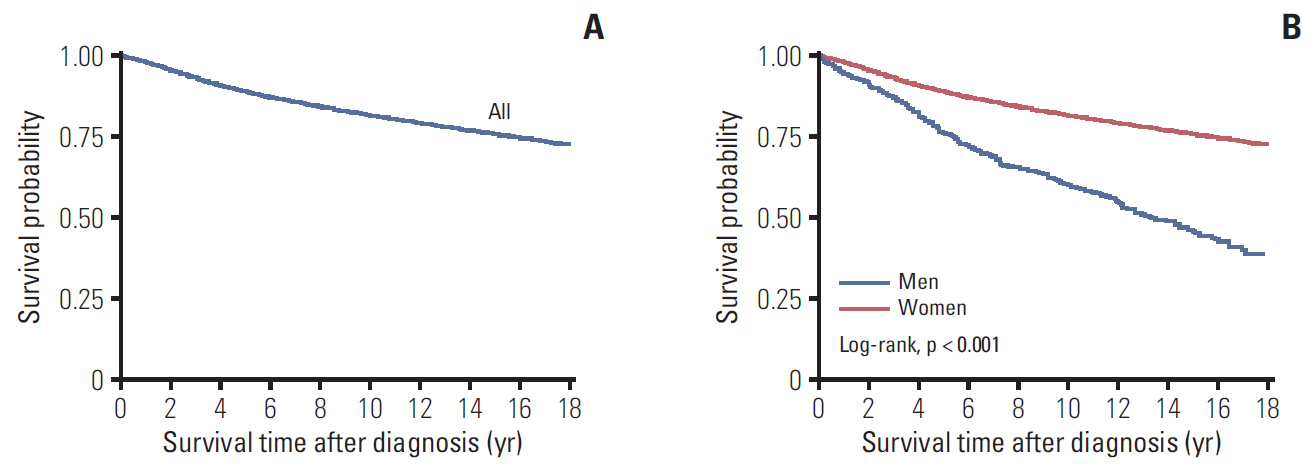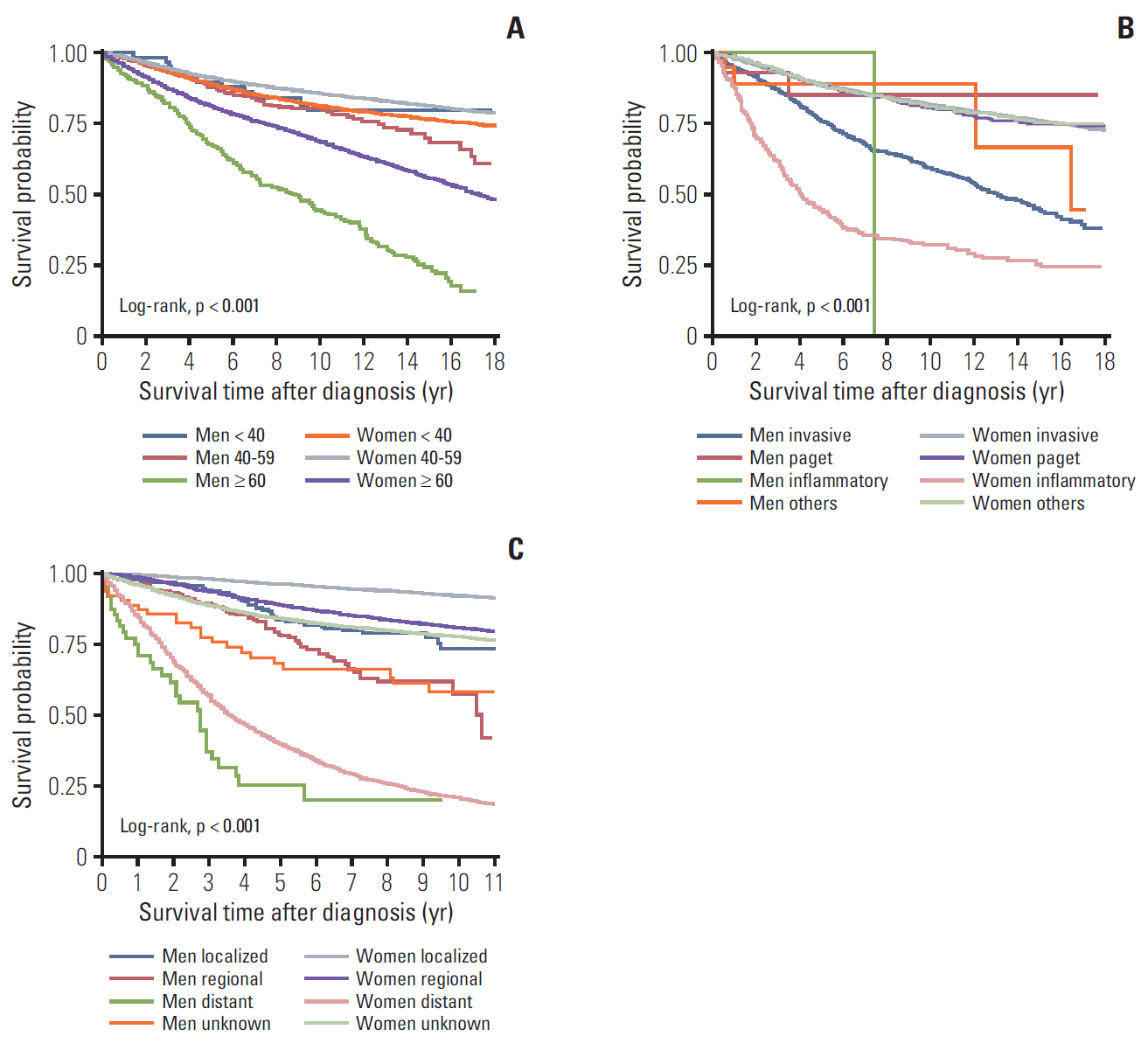Cancer Res Treat.
2020 Jul;52(3):739-746. 10.4143/crt.2019.639.
Comparing the Characteristics and Outcomes of Male and Female Breast Cancer Patients in Korea: Korea Central Cancer Registry
- Affiliations
-
- 1Center for Breast Cancer, National Cancer Center, Goyang, Korea
- 2Cancer Healthcare Research Branch, Research Institute, National Cancer Center, Goyang, Korea
- 3Center for Uterine Cancer, Research Institute and Hospital, National Cancer Center, Goyang, Korea
- 4Gynecologic Cancer Branch, Research Institute and Hospital, National Cancer Center, Goyang, Korea
- 5Department of Cancer Control and Population Health, National Cancer Center Graduate School of Cancer Science and Policy, National Cancer Center, Goyang, Korea
- 6Division of Cancer Registration and Surveillance, National Cancer Control Institute, National Cancer Center, Goyang, Korea
- 7Immunotherapeutics Branch, Research Institute, National Cancer Center, Goyang, Korea
- 8National Cancer Center Graduate School of Cancer Science and Policy, Goyang, Korea
- KMID: 2504456
- DOI: http://doi.org/10.4143/crt.2019.639
Abstract
- Purpose
This study aimed to determine the incidence of male breast cancer (MBC) and its survival outcomes in Korea, and to compare these results to those for female breast cancer (FBC).
Materials and Methods
We searched the Korea Central Cancer Registry and identified 227,122 breast cancer cases that were diagnosed between 1999 and 2016. Demographic and clinical characteristics and overall survival (OS) rates were estimated according to sex, age, histological type, and cancer stage.
Results
The 227,122 patients included 1,094 MBC cases and 226,028 FBC cases. Based on the age-standardized rate, the male: female ratio was 0.0055:1. The most common ages at diagnosis were 60-69 years for MBC and 40-49 years for FBC (p < 0.001). Male patients were less likely than female patients to receive adjuvant radiotherapy (7.5% vs. 21.8%, p < 0.001) or adjuvant chemotherapy (40.1% vs. 55.4%, p < 0.001). The 5-year OS rates after diagnosis were 88.8% for all patients, although it was significantly lower for MBC than for FBC (76.2% vs. 88.9%, p < 0.001). In both groups, older age (≥ 60 years) was associated with shorter survival. The 5-year OS rates for the invasive histological types were 75.8% for men and 89.0% for women. The 5-year OS rates in both groups decreased with increasing cancer stage.
Conclusion
MBC was diagnosed at older ages than FBC, and male patients were less likely to receive radiotherapy and chemotherapy. The survival outcomes were worse for MBC than for FBC, with even poorer outcomes related to older age, the inflammatory histological types, and advanced stage. It is important that clinicians recognize the differences between FBC and MBC when treating these patients.
Keyword
Figure
Reference
-
References
1. Jemal A, Siegel R, Xu J, Ward E. Cancer statistics, 2010. CA Cancer J Clin. 2010; 60:277–300.
Article2. Ferlay J, Soerjomataram I, Dikshit R, Eser S, Mathers C, Rebelo M, et al. Cancer incidence and mortality worldwide: sources, methods and major patterns in GLOBOCAN 2012. Int J Cancer. 2015; 136:E359–86.
Article3. Giordano SH, Cohen DS, Buzdar AU, Perkins G, Hortobagyi GN. Breast carcinoma in men: a population-based study. Cancer. 2004; 101:51–7.4. Hong JH, Ha KS, Jung YH, Won HS, An HJ, Lee GJ, et al. Clinical features of male breast cancer: experiences from seven institutions over 20 years. Cancer Res Treat. 2016; 48:1389–98.
Article5. Anderson WF, Jatoi I, Tse J, Rosenberg PS. Male breast cancer: a population-based comparison with female breast cancer. J Clin Oncol. 2010; 28:232–9.
Article6. Liu N, Johnson KJ, Ma CX. Male breast cancer: an updated Surveillance, Epidemiology, and End Results data analysis. Clin Breast Cancer. 2018; 18:e997–1002.
Article7. Gomez-Raposo C, Zambrana Tevar F, Sereno Moyano M, Lopez Gomez M, Casado E. Male breast cancer. Cancer Treat Rev. 2010; 36:451–7.8. World Health Organization. International statistical classification of diseases and related health problems. 10th rev. Geneva: World Health Organization;1994.9. Jung KW, Won YJ, Kong HJ, Lee ES. Cancer statistics in Korea: incidence, mortality, survival, and prevalence in 2016. Cancer Res Treat. 2019; 51:417–30.
Article10. Esteve J, Benhamou E, Raymond L. Statistical methods in cancer research. Volume IV. Descriptive epidemiology. IARC Sci Publ. 1994; (128):1–302.11. Hill TD, Khamis HJ, Tyczynski JE, Berkel HJ. Comparison of male and female breast cancer incidence trends, tumor characteristics, and survival. Ann Epidemiol. 2005; 15:773–80.
Article12. White J, Kearins O, Dodwell D, Horgan K, Hanby AM, Speirs V. Male breast carcinoma: increased awareness needed. Breast Cancer Res. 2011; 13:219.
Article13. Ioka A, Tsukuma H, Ajiki W, Oshima A. Survival of male breast cancer patients: a population-based study in Osaka, Japan. Jpn J Clin Oncol. 2006; 36:699–703.
Article14. Giordano SH. A review of the diagnosis and management of male breast cancer. Oncologist. 2005; 10:471–9.
Article15. Miao H, Verkooijen HM, Chia KS, Bouchardy C, Pukkala E, Laronningen S, et al. Incidence and outcome of male breast cancer: an international population-based study. J Clin Oncol. 2011; 29:4381–6.
Article16. Giordano SH, Buzdar AU, Hortobagyi GN. Breast cancer in men. Ann Intern Med. 2002; 137:678–87.
Article17. Choi MY, Lee SK, Lee JE, Park HS, Lim ST, Jung Y, et al. Characterization of Korean male breast cancer using an online nationwide breast-cancer database: matched-pair analysis of patients with female breast cancer. Medicine (Baltimore). 2016; 95:e3299.18. Fentiman IS, Fourquet A, Hortobagyi GN. Male breast cancer. Lancet. 2006; 367:595–604.
Article19. Erlichman C, Murphy KC, Elhakim T. Male breast cancer: a 13-year review of 89 patients. J Clin Oncol. 1984; 2:903–9.
Article20. Gough DB, Donohue JH, Evans MM, Pernicone PJ, Wold LE, Naessens JM, et al. A 50-year experience of male breast cancer: is outcome changing? Surg Oncol. 1993; 2:325–33.
Article21. Chakravarthy A, Kim CR. Post-mastectomy radiation in male breast cancer. Radiother Oncol. 2002; 65:99–103.
Article22. Yu E, Suzuki H, Younus J, Elfiki T, Stitt L, Yau G, et al. The impact of post-mastectomy radiation therapy on male breast cancer patients: a case series. Int J Radiat Oncol Biol Phys. 2012; 82:696–700.23. Jung SY, Jung KW, Ha J, Won YJ, Kim YA, Kwon Y, et al. Different patterns of conditional survival of breast cancer patients by age and histologic types: evidence from the Korean nationwide registry. Cancer Epidemiol Biomarkers Prev. 2019; 28:1169–76.
Article24. Gnerlich JL, Deshpande AD, Jeffe DB, Seelam S, Kimbuende E, Margenthaler JA. Poorer survival outcomes for male breast cancer compared with female breast cancer may be attributable to in-stage migration. Ann Surg Oncol. 2011; 18:1837–44.
Article25. Scott-Conner CE, Jochimsen PR, Menck HR, Winchester DJ. An analysis of male and female breast cancer treatment and survival among demographically identical pairs of patients. Surgery. 1999; 126:775–80.
Article26. Marchal F, Salou M, Marchal C, Lesur A, Desandes E. Men with breast cancer have same disease-specific and event-free survival as women. Ann Surg Oncol. 2009; 16:972–8.
Article27. Bharat A, Aft RL, Gao F, Margenthaler JA. Patient and tumor characteristics associated with increased mortality in young women (< or =40 years) with breast cancer. J Surg Oncol. 2009; 100:248–51.28. Gnerlich JL, Deshpande AD, Jeffe DB, Sweet A, White N, Margenthaler JA. Elevated breast cancer mortality in women younger than age 40 years compared with older women is attributed to poorer survival in early-stage disease. J Am Coll Surg. 2009; 208:341–7.
Article29. Berglund A, Wigertz A, Adolfsson J, Ahlgren J, Fornander T, Warnberg F, et al. Impact of comorbidity on management and mortality in women diagnosed with breast cancer. Breast Cancer Res Treat. 2012; 135:281–9.
Article30. Mohamad HB, Apffelstaedt JP. Counseling for male BRCA mutation carriers: a review. Breast. 2008; 17:441–50.
- Full Text Links
- Actions
-
Cited
- CITED
-
- Close
- Share
- Similar articles
-
- Annual Report of the Korea Central Cancer Registry Program 2000: Based on Registered Data from 131 Hospitals
- Breast Cancer Statistics in Korea, 2021
- Breast Cancer Statistics in Korea, 2019
- The Basic Facts of Korean Breast Cancer in 2013: Results of a Nationwide Survey and Breast Cancer Registry Database
- Treatment Patterns and Outcomes of Young Female Early Breast Cancer in Taiwan



